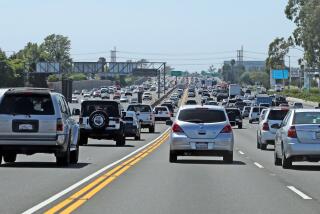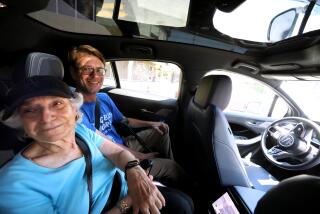New roadblocks to drunk driving
On the state Capitol steps, representatives from national traffic safety organizations, law enforcement groups and health advocates will gather Tuesday to deliver a warning to holiday revelers: If you drink, don’t drive.
The message has a distinctly familiar ring, but that’s where similarities to past drunk-driving campaigns end. This year has marked a seismic shift in efforts by law enforcement groups, Mothers Against Drunk Driving and other safety organizations to halt the behavior that accounts for 39% of traffic deaths.
Alcohol-related traffic fatalities fell dramatically between 1982 and about 1994, largely due to the efforts of MADD as well as laws to lower the drunk-driving limit to a blood-alcohol concentration of 0.08 milligrams per 100 milliliters of blood.
But that trend has stalled. Since 1994, alcohol-related driving fatalities in the United States have plateaued at around 17,000 per year, and, in California, between 2004 and 2005 they inched upward.
Traffic-safety advocates say they have stepped up efforts to stop drunk driving, but have not made much progress, says Susan Ferguson, senior vice president of the Insurance Institute for Highway Safety, a nonprofit, scientific and educational organization dedicated to reducing crashes on the nation’s highways. “It was time to revisit this,” Ferguson says.
The most obvious change -- one that will be visible to many people over the upcoming holiday season -- is widespread sobriety checkpoints. A similar nationwide crackdown during Labor Day, the largest ever, involved 11,500 law enforcement agencies and an $11-million publicity campaign. (The effect of that effort on accident statistics is still being assessed.)
But other innovative ideas to eliminate drunk driving are also under review. Last month, MADD announced what it calls an “audacious” campaign to end drunk driving largely through harnessing new technology that may someday make it impossible to start a car when the driver has had too much to drink.
Hitting a plateau
Drunk driving has been transformed from “something that was normal behavior in 1980, and even a joke on late-night television, to something that is socially unacceptable but tolerated,” says MADD chief executive Chuck Hurley. “What we’re trying to do is move the issue to ‘not tolerated.’ ”
Far too many drunk drivers still traverse the nation’s roadways, Hurley says. According to the FBI, 1.4 million driving under the influence (DUI) arrests were made last year. Studies show that on average, those who drive while drunk make about 50 car trips while intoxicated before getting caught. Even after they’re arrested, Ferguson says, many still drink and drive.
That realization, along with a lack of progress in reducing DUI fatalities and injuries, prompted the renewed focus.
MADD has called for increased law enforcement activity and much wider use of technology, such as ignition interlocks, which make it impossible to operate a vehicle while intoxicated. Such interlocks have been available for many years but are beginning to attract new interest.
The devices, in which a Breathalyzer is linked to the vehicle’s ignition system, are most often ordered by judges for repeated DUI offenders as a condition of probation after the driver’s license has been reinstated. But fewer than 10% of convicted drunk drivers (about 100,000) receive one each year.
MADD is pushing for the use of interlocks for all convicted first-time offenders, a move that the organization estimates could save 1,600 lives a year. Last year, New Mexico became the first state in the nation to enact such legislation. The state has experienced a 20% decline in alcohol-related fatalities since then, Hurley says. Preliminary discussions involving MADD and state lawmakers have begun in California regarding a similar interlock bill.
Through such expanded legislation, MADD hopes to get a vastly increased number -- 500,000 to 700,000 -- of the devices fitted to the cars of convicted drunk drivers within the next five years, Hurley says.
In turn, the increased use of interlocks is expected to pave the way for devices that would be installed in all new cars to help prevent drunk driving. A blue ribbon panel was launched this year by MADD and major traffic safety organizations to explore the issue.
Unlike interlocks, which are conspicuous and require frequent calibration, technology for the average driver would need to be moderately priced, reliable, unobtrusive and set at the legal blood-alcohol concentration, proponents say.
A less-intrusive Breathalyzer is one possibility. Saab automobile in Sweden is testing what it calls an Alcokey -- a miniature alcohol-sensing device on the car’s key fob (the security hardware device that is built into most conventional car keys). When the driver presses the “door open” button on the key, the alcohol sensor also switches on. The driver then blows into a small mouthpiece at the end of the fob to provide a breath sample linked to the car’s engine.
Noninvasive options
But devices that avoid Breathalyzers or any action on the part of the driver hold even more promise, most experts say. A New Mexico company, TruTouch Technologies Inc., has developed a touch-based alcohol-monitoring technology that measures alcohol harmlessly through the skin using infrared spectroscopy. (The idea grew from similar technology that is used to measure glucose levels in people with diabetes.) A touchpad could be placed on a steering wheel or keychain that would measure the driver’s alcohol level and transmit the information to the ignition system, says Jim McNally, founder and chief executive of TruTouch.
The device also allows for an analysis of individual tissue chemistry that ensures that the person being monitored is actually the person designated to drive the car, McNally adds. One problem with Breathalyzers is that a passenger or someone else can blow into the device to start a car.
The company hopes to market an automobile device within three to five years.
Another through-the-skin, or transdermal, approach under study would measure alcohol in sweat secreted from the skin. Such technology is already used in a device called a Secure Continuous Remote Alcohol Monitor, or SCRAM -- an ankle bracelet that can continuously monitor alcohol intake. The device is sometimes ordered by judges for people convicted of alcohol-related crimes, including DUI, and is being used in a small pilot study in Riverside County to monitor several convicted DUI offenders as a condition of their probation.
Other options under study are devices that would track involuntary eye movements, such as nystagmus -- a jerkiness of the eye that is related to alcohol use and drowsiness.
The challenge, says Ferguson, is to refine the technology so that it’s completely reliable, quick and convenient. “This has to be something that doesn’t have you going through hoops to get your car started,” she says. “You can imagine the soccer mom stopping here and there,” she says. “You don’t want that person blowing into a device. No one would want that.”
Whether the public will accept such technology for all drivers, not just ones with drunk-driving track records, is unclear.
“Any technology in a car of the future has to be low-cost, invisible to the sober driver and set at the legal limit,” says William Georges, senior vice president of the Century Council, a nonprofit organization funded by distilled spirits companies to address underage drinking and drunk driving. “If I go out to dinner and have a glass of wine, I need to be able to start my car.”
The Century Council has joined MADD in support of its new campaign, Georges adds. The group endorses use of current interlock technology for “hard-core drunk drivers.”
Hurley says MADD aims to work closely with law enforcement groups, automakers and the alcoholic beverage industry to bring their goals to fruition.
“We are hopeful that new cars can be offered in 10 years that would not be operational at a blood alcohol concentration of 0.08 or above,” he says. “There is consensus in the automobile safety community that the technology can be ready in about 10 years. Cars are getting smarter every day. Cars can even park themselves now.”
More to Read
Sign up for Essential California
The most important California stories and recommendations in your inbox every morning.
You may occasionally receive promotional content from the Los Angeles Times.










